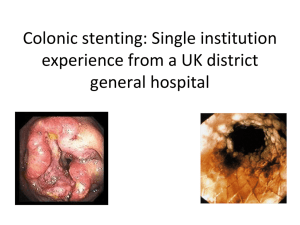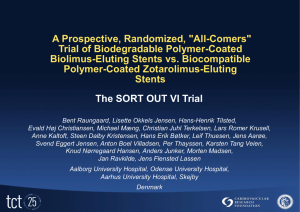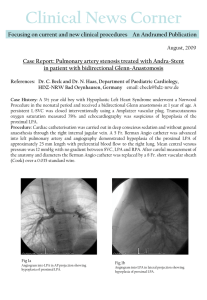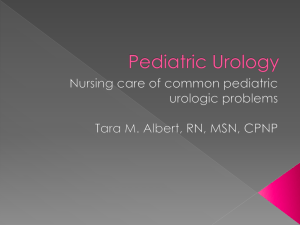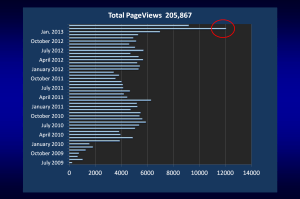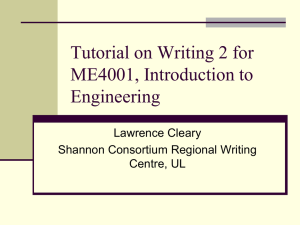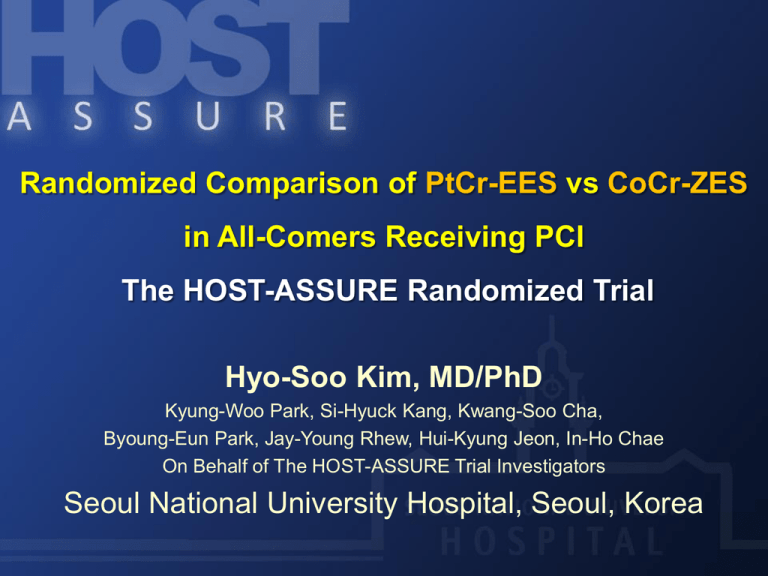
Randomized Comparison of PtCr-EES vs CoCr-ZES
in All-Comers Receiving PCI
The HOST-ASSURE Randomized Trial
Hyo-Soo Kim, MD/PhD
Kyung-Woo Park, Si-Hyuck Kang, Kwang-Soo Cha,
Byoung-Eun Park, Jay-Young Rhew, Hui-Kyung Jeon, In-Ho Chae
On Behalf of The HOST-ASSURE Trial Investigators
Seoul National University Hospital, Seoul, Korea
Disclosures
Kim HS reports receiving honorarium for
lectures and research grants from Boston
Scientific and Medtronic.
Background
• Second-generation DES have improved clinical outcome compared
with first-generation DES.
• Resolute (Medtronic, Minneapolis, MN, USA) is a CoCr-based
zotarolimus-eluting stent (CoCr-ZES) that showed equivalent
outcome to Xience (CoCr-based everolimus-eluting stent).
• Promus Element (Boston Scientific, Natick, MA, USA) is a PtCrbased EES (PtCr-EES) that has limited clinical data regarding the
efficacy and safety.
• No study to compare Promus-Element vs. Resolute.
• No data on the real picture of longitudinal stent deformation
(LSD) in these newer generation DES based on the systemic review
of angiographs in the prospectively-collected cohort.
Objectives
PtCr-EES
(Promus-Element)
vs.
CoCr-ZES
(Resolute)
[Hypothesis]
PtCr-EES is Non-Inferior to CoCr-ZES
Regarding Target Lesion Failure at 12 month
Longitudinal Stent Deformation (LSD) : a trade-off of thin strut
How often does it happen?
Under what conditions does it occur?
How severe can it be?
Study Design
Prospective, single-blinded, randomized multi-center trial
3,750 All Comers Receiving PCI
40 Centers in Korea
Coronary Angiography
PtCr-EES arm
(N=2,500)
2:1 Randomization
CoCr-ZES arm
(N=1,250)
Percutaneous Coronary Intervention
Target Lesion Failure at 12 Months Post-PCI (Intention-To-Treat Analysis)
Enrollment Criteria
General Inclusion Criteria
• Age ≥18 years
• Ability to verbally confirm understandings
of risks, benefits and treatment
alternatives with written informed consent
prior to any study-related procedure
• Significant lesion (>50% by visual
estimate) in any of the coronary arteries,
venous or arterial bypass grafts
• Evidence of myocardial ischemia
or diameter stenosis > 70%
Angiographic Inclusion Criteria
• Target lesion in coronary artery, venous
or arterial bypass graft with diameter of ≥
2.5 mm and ≤ 4.25 mm
• Target lesion amenable for PCI
Exclusion Criteria
•
•
•
•
•
•
•
•
•
LVEF <25% or cardiogenic shock
Symptomatic heart failure
Life expectancy <1 year
History of bleeding diathesis, known
coagulopathy (including HIT), abnormal
CBC (Hb < 10 g/dL or PLT < 100k /μL) or
refusal of blood transfusions
GI or GU bleeding ≤ 3 months
or major surgery ≤ 2 months
Known hypersensitivity/contraindication
to heparin, aspirin, clopidogrel, cilostazol,
everolimus, zotarolimus, or contrast
media
Systemic (intravenous) Everolimus or
Zotarolimus use ≤ 12 months
Female of childbearing potential
Actively participating in another drug or
device investigational study
Study Endpoints
• Primary Endpoint: Target Lesion Failure at 12 Month
(a composite of cardiac death, TV-related MI, and ischemia-driven TLR)
• Secondary Endpoints
– Individual components of TLF: cardiac death, TV-related MI, ID-TLR
– Patient-oriented composite outcome
: all-cause death, all-cause MI, all repeat revascularization
– Definite or probable ST (according to ARC definition)
•
Detection of Longitudinal Stent Deformation (LSD)
: by visual estimation of angiograph at index PCI
Statistical Assumption
Non-inferiority Design for Primary Endpoint
(TLF at 12 Months)
• Assumption : TLF
– 6.5% in PtCr-EES group
– 6.5% in CoCr-ZES group
TLF = 4 ~ 8% (COMPARE-II, PLATINUM, SPIRIT-IV, RESOLUTE-AC)
• Non-inferiority Margin: Hazard Ratio 1.5 (1-sided)
– Type I error (1-sided α): 2.5%
– Sampling ratio = 2:1
– Attrition rate: 5%
– Primary Analysis: Intention-to-treat analysis
– Statistical power >80% (β<0.20)
N=3,750
Trial Coordination
Principal
Investigator
Hyo-Soo Kim
Executive
Committee
Hyo-Soo Kim, In-Ho Chae, Kwang Soo Cha,
Byoung Eun Park, Jay Young Rhew, Hui-Kyung Jeon
Data Management
Dream CIS Inc. (contract research organization)
Random Sequence
Generation
Web-based online randomization system
Data Safety
Monitoring Board
Seung-Woo Park, Young-Jin Choi, Kwangil Kim
Clinical Event
Adjudication
Committee
Yong-Seok Kim, Sang Min Park, Kyung-Il Park
(blinded to treatment allocation)
Participating Centers
40 major hospitals in Republic of Korea
Site
PI
Site
PI
Seoul National University Hospital
Kim, Hyo-Soo
Konyang University Hospital
Bae, Jang-Ho
Seoul National University Bundang Hospital
Chae, In-Ho
Hallym University Kangdong Sacred Heart Hospital
Han, Kyoo-Rok
Pusan National University Hospital
Cha, Kwang Soo
Ewha Womans University Mokdong Hospital
Park, Si-Hoon
Dankook University Hospital
Park, Byoung Eun
Korea University Guro Hospital
Rha, Seung-Woon
Presbyterian Medical Center
Rhew, Jay Young
Hallym University Sacred Heart Hospital
Park, Woo-Jung
Uijeongbu St. Mary’s Hospital
Jeon, Hui-Kyung
Wongwang University Hospital
Oh, Seok-Kyu
Ulsan University Hospital
Shin, Eun Seok
Korea University Anam Hospital
Lim, Do-Sun
Samsung Changwon Hospital
Oh, Ju Hyeon
Kwangju Christian Hospital
Lee, Seung-Wook
Chonnam National University Hospital
Jeong, Myung-Ho
Hallym University Chuncheon Sacred Heart Hospital
Hyun Hee Choi
Chungbuk National University Hospital
Hwang, Kyung-Kuk
Kyung Hee University Hospital at Gangdong
Kim, Chong-Jin
Wonju Christian Hospital
Yoon, Jung-Han
Seoul Medical Center
Kim, Seok-Yeon
Inje University Ilsan Paik Hospital
Lee, Sung Yun
Gachon University Gil Hospital
Ahn, Taehoon
Boramae Medical Center
Kim, Sanghyun
Samsung Medical Center
Gwon, HyeonCheol
Dong-A Medical Center
Park, Tae-Ho
Hallym University Kangnam Sacred Heart Hospital
Lee, Namho
Gangnam Severance Hospital
Kwon, Hyuck-Moon
National Health Insurance Medical Center
Jeon, Dong-Woon
St. Vincent’s Hospital
Moon, Keon Woong
Soonchunhyang University Hospital
Hyun, Min-Soo
Daegu Catholic University Medical Center
Ryu, Jae-Kean
Daejun Eulji University Hospital
Yu Jeong Choi
Keimyung University Dongsan Medical Center
Hur, Seung-Ho
Hanyang University Guri Hospital
Seong Il Choe
Daegu Fatima Hospital
Lee, Bong-Ryul
Kangwon National University Hospital
Ryu, Dong Ryeol
Gyeongsang National University Hospital
Park, Yong-Whi
Kosin University Gospel Hospital
Cha, Tae-Joon
Trial Flow
3,755 Patients
Enrolled and Randomized
Allocated to PtCr-EES
N=2,503
17 withdrew
14 voluntarily
3 by physician’s decision
16 were lost to follow up
Completed 1-Year F/U
N=2,470 (98.7%)
Allocated to CoCr-ZES
N=1,252
9 withdrew
7 voluntarily
2 by physician’s decision
7 were lost to follow up
Completed 1-Year F/U
N=1,236 (98.7%)
Baseline Characteristics
Characteristic
Age
Men
Body mass index
Hypertension
Diabetes
Dyslipidemia
Current smoker
Chronic renal failure
Peripheral artery disease
Cerebrovascular disease
Previous PCI
Previous bypass surgery
Pervious MI
Previous CHF
Clinical diagnosis
Slient ischemia
Stable angina
Unstable angina
ACS
NSTEMI
65.5%
STEMI
PtCr-EES
CoCr-ZES
(N=2,503)
63.1±10.8
1,746 (69.8)
24.6±3.2
1,706 (68.2)
795 (31.8)
1,601 (64.0)
823 (32.9)
59 (2.4)
41 (1.6)
172 (6.9)
247 (9.9)
16 (0.6)
116 (4.6)
41 (1.6)
(N=1,252)
63.5±10.7
820 (65.6)
24.7±3.2
852 (68.1)
401 (32.0)
822 (65.7)
369 (29.5)
36 (2.9)
27 (2.2)
79 (6.3)
120 (9.6)
10 (0.8)
49 (3.9)
13 (1.0)
119 (4.8)
746 (29.8)
903 (36.1)
452 (18.1)
283 (11.3)
63 (5.0)
367 (29.3)
476 (38.0)
209 (16.7)
137 (10.9)
Baseline Characteristics
PtCr-EES
CoCr-ZES
(N=2,503)
(N=1,252)
Left ventricular ejection fraction (%)
59.9±10.4
60.4±10.2
Hemoglobin (g/dL)
13.7±1.7
13.7±1.7
Platelet count (x103/mm)
227±61
227±64
Serum creatinine (mg/dL)
1.00±0.73
1.00±0.87
Total cholesterol (mg/dL)
177±43
178±45
Triglyceride (mg/dL)
138±87
144±107
HDL-cholesterol (mg/dL)
44±12
44±11
LDL-cholesterol (mg/dL)
110±41
109±38
Aspirin
2,485 (99.3)
1,247 (99.6)
Clopidogrel
2,483 (99.2)
1,246 (99.5)
β-blocker
1,710 (68.3)
845 (67.5)
526 (21.0)
236 (18.8)
ACE inhibitor or ARB
1,636 (65.4)
829 (66.2)
Statin
2,122 (84.8)
1,076 (85.9)
Characteristic
Laboratory findings
Medications at discharge
Calcium channel blocker
Lesion & Procedural Characteristics
Characteristic
Patient-Level
Angiographic disease extent:
1VD
2VD
3VD
Target lesions to be treated:
One
Two
≥ Three
Use of IVUS or OCT
Use of glycoprotein IIb/IIIa inhibitors
Lesion-Level
Target vessel location:
LMCA
LAD
LCX
RCA
ACC/AHA classification B2/C type
Total occlusion
Thrombus-containing
Bifurcation
PtCr-EES
CoCr-ZES
(N=2,503)
(N=1,252)
1,150 (45.9)
807 (32.2)
546 (21.8)
580 (46.3)
400 (31.9)
272 (21.7)
1,766 (70.6)
570 (22.8)
167 (6.7)
1,037 (41.4)
55 (2.2)
909 (72.6)
286 (22.8)
57 (4.6)
494 (39.5)
37 (3.0)
(N=3,426)
(N=1,661)
74 (2.2)
1,623 (47.4)
751 (21.9)
978 (28.5)
1,662 (49.7)
422 (12.3)
45 (1.3)
874 (25.6)
37 (2.2)
852 (51.3)
324 (19.5)
448 (27.0)
842 (51.7)
193 (11.6)
25 (1.5)
420 (25.3)
QCA Analysis
PtCr-EES
CoCr-ZES
(N=2,938)
(N=1,425)
Before index procedure
Lesion length
Reference vessel diameter
Minimum lumen diameter
Percent stenosis – %
SYNTAX score, before procedure
19.3±11.8
3.00±0.50
0.81±0.50
73.1±15.4
12.1±8.0
19.8±12.4
3.00±0.50
0.81±0.50
72.8±15.5
12.4±8.1
0.229
0.457
0.657
0.470
0.299
After index procedure
SYNTAX score, after procedure
Number of stents
Per lesion
Per patient
Total stent length – mm
Per lesion
Per patient
Minimum lumen diameter
In-stent
In-segment
Diameter stenosis – %
In-stent
In-segment
Acute gain – mm
In-stent
In-segment
4.0±5.4
1.19±0.45
1.62±0.92
27.7±13.3
37.6±24.2
2.61±0.43
2.23±0.53
11.0±7.4
21.5±11.2
1.80±0.53
1.42±0.58
4.0±5.4
1.17±0.43
1.56±0.85
28.7±14.6
37.9±25.0
2.62±0.45
2.21±0.52
11.2±8.1
22.2±11.4
1.81±0.55
1.40±0.59
0.852
0.301
0.061
0.022
0.764
0.465
0.397
0.538
0.051
0.798
0.275
Characteristic
P Value
Target Lesion Failure
Composite of C-death, TV-related MI, ischemia-driven TLR
HR: 1.00 (0.67-1.50)
Non-Inferiority P-value (1-sided)=0.02
Superiority P-value=0.98
Target Lesion Failure (%)
5.0
4.0
PtCr-EES: 2.9%
3.0
2.0
CoCr-ZES: 2.9%
1.0
0.0
0
2
4
6
8
10
12
Months After Enrollment
Patient Number At Risk
PtCr-EES
2,503
2,446
2,426
2,408
2,401
2,376
1,887
CoCr-ZES
1,252
1,222
1,213
1,209
1,205
1,198
952
Hypothesis Testing
Non-inferiority P=0.0247
Predefined margin
: 1.5
1.4986 : Upper 97.5% CI
0.5
1.0
1.5
Predefined
Non-Inferiority
Margin
0.6
P-value Function Curve
0.4
1-sided
80% CI
0.2
90% CI
95% CI
α=0.0247
97.5% CI
0.0
p-value
0.8
1.0
Hazard Ratio of PtCr-EES vs. CoCr-ZES
0.5
1.0
1.5
Hazard Ratio of PtCr-EES vs. CoCr-ZES
2.0
Clinical Outcomes
End point
Target Lesion Failure
All-Cause Death
Cardiac Death
All-Cause MI
Target Vessel-Related MI
Repeat Revascularization
Target Lesion Revascularization
Target Vessel Revascularization
Cerebrovascular Accident
Ischemic
Hemorrhagic
All PLATO Bleeding
Major Bleeding
Major, life-threatening
Major, other
Minor Bleeding
Target Vessel Failure
Patient-Oriented Clinical Outcome
PtCr-EES
CoCr-ZES
(N=2,503)
72 (2.88%)
56 (2.24%)
34 (1.36%)
28 (1.12%)
24 (0.96%)
74 (2.96%)
31 (1.24%)
42 (1.68%)
17 (0.68%)
15 (0.60%)
2 (0.08%)
45 (1.80%)
27 (1.08%)
4 (0.16%)
23 (0.92%)
18 (0.72%)
82 (3.28%)
135 (5.39%)
(N=1,252)
36 (2.88%)
20 (1.60%)
17 (1.36%)
17 (1.36%)
13 (1.04%)
33 (2.64%)
15 (1.20%)
23 (1.84%)
8 (0.64%)
6 (0.48%)
2 (0.16%)
25 (2.00%)
16 (1.28%)
4 (0.32%)
13 (1.04%)
9 (0.72%)
42 (3.35%)
55 (4.39%)
HR (95% CI)
1.00 (0.67-1.50)
1.40 (0.84-2.34)
1.00 (0.56-1.79)
0.83 (0.45-1.51)
0.93 (0.47-1.82)
1.13 (0.75-1.70)
1.04 (0.56-1.93)
0.92 (0.55-1.53)
1.07 (0.46-2.47)
1.26 (0.49-3.24)
0.50 (0.07-3.55)
0.90 (0.55-1.47)
0.84 (0.45-1.57)
0.50 (0.13-2.00)
0.89 (0.45-1.75)
1.00 (0.45-2.23)
0.98 (0.68-1.42)
1.24 (0.90-1.69)
P-value
0.983
0.194
0.997
0.533
0.822
0.557
0.900
0.746
0.879
0.636
0.489
0.674
0.591
0.327
0.725
0.996
0.919
0.187
Clinical Events at 12 Months
Cardiac Death
TV related-MI
Target Lesion
Revascularization
Patient-Oriented
Composite
p=0.997
p=0.822
p=0.900
p=0.187
5.4%
4.4%
1.4%
1.4%
PtCr-EES CoCr-ZES
N=2,503
N=1,252
1.0%
1.0%
PtCr-EES CoCr-ZES
N=2,503
N=1,252
1.2%
1.2%
PtCr-EES CoCr-ZES
N=2,503
N=1,252
PtCr-EES CoCr-ZES
N=2,503
N=1,252
Stent Thrombosis
PtCr-EES
(N=2,503)
Definite or probable ST
Acute definite or probable ST
Subacute definite or probable ST
Early definite or probable ST
Late definite or probable ST
Definite ST
Acute definite ST
Subacute definite ST
Early definite ST
Late definite ST
Probable ST
Acute probable ST
Subacute probable ST
Early probable ST
Late probable ST
Possible ST
Acute possible ST
Subacute possible ST
Early possible ST
Late possible ST
9
1
7
8
1
5
0
5
5
0
4
1
2
3
1
15
0
0
0
15
(0.36%)
(0.04%)
(0.28%)
(0.32%)
(0.04%)
(0.20%)
(0.00%)
(0.20%)
(0.20%)
(0.00%)
(0.16%)
(0.04%)
(0.08%)
(0.12%)
(0.04%)
(0.60%)
(0.00%)
(0.00%)
(0.00%)
(0.60%)
Late possible ST : Any unexplained death beyond 30 days
CoCr-ZES
(N=1,252)
8
1
6
7
1
3
1
1
2
1
5
0
5
5
0
6
0
0
0
6
(0.67%)
(0.08%)
(0.50%)
(0.58%)
(0.08%)
(0.25%)
(0.08%)
(0.08%)
(0.17%)
(0.08%)
(0.42%)
(0.00%)
(0.42%)
(0.42%)
(0.00%)
(0.50%)
(0.00%)
(0.00%)
(0.00%)
(0.50%)
p-value
0.229
1.000
0.379
0.273
1.000
1.000
0.333
0.671
1.000
0.333
0.171
1.000
0.045
0.127
1.000
0.642
0.642
Stent Thrombosis
Definite ST
Probable ST
p=1.000
p=0.171
Definite or
Probable ST
Possible ST
p=0.642
p=0.229
0.67%
0.60%
0.50%
0.42%
0.20%
0.25%
PtCr-EES CoCr-ZES
N=2,503
N=1,252
0.36%
0.16%
PtCr-EES CoCr-ZES
N=2,503
N=1,252
PtCr-EES CoCr-ZES
N=2,503
N=1,252
PtCr-EES CoCr-ZES
N=2,503
N=1,252
Subgroup Analysis
Subgroup
Age
≥65 years
<65 years
Sex
Men
Women
Acute Coronary Syndrome
Yes
No
Diabetes Mellitus
Yes
No
Number of Lesions to be Treated
One
More than two
Lesion Length
≤ 20 mm
> 20 mm
Reference Vessel Diameter
≤ 2.75 mm
> 2.75 mm
Multivessel Stenting
Yes
No
Allocated Antiplatelet Arm
Triple Antiplatelet
Double Dose Dual Antiplatelet
Overall
Target Lesion Failure
PtCr-EES
CoCr-ZES
47/1182 (4.0)
25/1321 (1.9)
27/617 (4.4)
9/635 (1.4)
P Value for
Interaction
Hazard Ratio (95% CI)
0.395
0.91 (0.57 -1.46)
1.35 (0.63 -2.90)
0.371
43/1746 (2.5)
29/757 (3.8)
23/820 (2.8)
13/432 (3.0)
0.88 (0.53 -1.46)
1.29 (0.67 -2.48)
50/1638 (3.1)
22/865 (2.5)
26/822 (3.2)
10/430 (2.3)
0.97 (0.60 -1.56)
1.09 (0.52 -2.31)
29/795 (3.6)
43/1708 (2.5)
15/401 (3.7)
21/851 (2.5)
0.97 (0.52 -1.81)
1.03 (0.61 -1.74)
53/1766 (3.0)
19/737 (2.6)
22/909 (2.4)
14/343 (4.1)
1.25 (0.76 -2.06)
0.63 (0.32 -1.25)
34/1575 (2.2)
27/623 (4.3)
14/765 (1.8)
18/340 (5.3)
1.24 (0.61 -2.50)
0.82 (0.47 -1.41)
0.779
0.912
0.114
0.346
0.030
31/983 (3.2)
39/1486 (2.6)
23/464 (5.0)
13/777 (1.7)
0.63 (0.37 -1.08)
1.58 (0.85 -2.97)
51/1858 (2.7)
21/645 (3.3)
23/927 (2.5)
13/325 (4.0)
0.82 (0.41 -1.63)
1.11 (0.68 -1.82)
0.471
0.885
37/1253 (3.0)
35/1250 (2.8)
19/626 (3.0)
17/626 (2.7)
0.97 (0.56 -1.69)
1.04 (0.58 -1.85)
72/2503 (2.9)
36/1252 (2.9)
1.00 (0.67 -1.50)
0.25
0.5
Favors PtCr-EES
1
2
4
Favors CoCr-ZES
Systematic review of CAG
to assess Longitudinal Stent Deformation
5,087 lesions (3,755 Patients)
PtCr-EES: 3,426
CoCr-ZES: 1,661
5,010 lesions (3,711 Patients)
PtCr-EES: 3,367
Acceptable
Angiographic Images
(98.5% of lesions)
CoCr-ZES: 1,643
3,772 lesions (3,016 Patients)
PtCr-EES: 2,516
Enrolled lesions
CoCr-ZES: 1,256
2,503 lesions (2,118 Patients)
1. Bifurcation stenting
2. Overlapping stenting
3. Different Projection angle
Nominal SLR
measurable
(74.3% of lesions)
No procedure
after deployment
•adjunctive ballooning
Post-Deployment SLR
•IVUS or OCT
measurable
(49.2% of lesions)
PtCr-EES: 1,685
CoCr-ZES: 818
“LSD”
Longitudinal Stent Deformation
3,755 Patients
(5,087 lesions)
Acceptable
angiographic
images
PtCr-EES
CoCr-ZES
2,503 Patients (3,426 lesions)
1,252 Patients (1,661 lesions)
PtCr-EES
CoCr-ZES
2,471 Patients (3,367 lesions)
1,240 Patients (1,643 lesions)
P=0.104
7 (0.21%)
0 (0.00%)
PtCr-EES
CoCr-ZES
Incidence: 2.1 (95% CI: 0.8-4.3) per 1,000 lesions treated with PtCr-EES
Longitudinal Stent Deformation
• Features of LSD by visual estimation
Details of 7 Patients with LSD
Additional
Segment of
Stenting
Stent Involved
Required
Future
Clinical
Events
Age
/Sex
Lesion
Loci
Stent Size
(mm)
Precipitating
Factor
Bifurcati
on
Ostial
Lesion
61/M
LMCA
P-E
3.0x24
Deep engagement of guiding
catheter (GC)
Yes
Yes
Proximal part
No
No
59/M
LMCA
P-E
3.0x28
Deep engagement of GC d/t
trapped retrograde guidewire
(CTO)
No
No
Proximal part
No
No
50/F
Mid LAD
P-E
4.0x28
Deep engagement of GC d/t
trapped IVUS catheter
No
No
Proximal part
No
No
72/M
Proximal
RCA
P-E
3.0x28
Deep engagement of GC d/t
trapped stent
No
No
Proximal part
No
No
39/M
Proximal
LAD
P-E
4.0x28
Advancing Adjunctive
Balloon catheter
Yes
No
Proximal part
No
No
81/F
Mid LAD
P-E
3.0x20
Advancing Adjunctive
Balloon catheter
Yes
No
Proximal part
Yes
No
68/M
Mid LAD
P-E
3.0x28
Advancing Adjunctive
Balloon catheter
No
No
Proximal part
No
No
Stent Length Ratio
: index of systemic assessment of stent shortening
Promus-Element: 3.0x28 mm
Before Deployment
: 24.27 mm
After Deployment
: 23.14 mm
Final
: 21.05 mm
d/t shortening
by projection angle
d/t shortening
by expansion
d/t shortening
by 1) LSD
2) projection angle difference
Nominal Stent Length Ratio
1.4
0.92±0.07 vs. 0.93±0.07
(P<0.001)
1.2
Maximum
75% Quartile
50% Median
25% Quartile
Minimum
1.0
0.8
0.6
PtCr-EES
CoCr-ZES
(2,516 lesions)
(1,256 lesions)
PtCr-EES CoCr-ZES
1.18
1.31
0.97
0.98
0.93
0.94
0.88
0.89
0.55
0.65
Nominal Stent Length Ratio
Final Stent Length
50 (mm)
Min
1st Q
Median
3rd Q
Max
PtCr-EES
0.545
0.883
0.931
0.971
1.181
CoCr-ZES
0.645
0.889
0.939
0.981
1.313
40
30
20
PtCr-EES: 0.92±0.07 (R2=0.906)
CoCr-ZES: 0.93±0.07 (R2=0.934)
10
0
(P<0.001)
0
20
40
Nominal Stent Length (mm)
60
Post-Deployment Stent Length Ratio
1.00±0.04 vs. 1.00±0.04
(P=0.352)
1.2
PtCr-EES CoCr-ZES
1.0
0.8
PtCr-EES
CoCr-EES
(1,685 lesions)
(818 lesions)
Maximum
1.29
1.30
75% Quartile
1.01
1.01
50% Median
1.00
1.00
25% Quartile
0.98
0.98
Minimum
0.78
0.85
Post-Deployment Stent Length Ratio
Final Stent Length (mm)
50
Min
1st Q
Median
3rd Q
Max
PtCr-EES
0.776
0.977
0.997
1.013
1.287
CoCr-ZES
0.846
0.980
1.000
1.013
1.295
40
30
20
PtCr-EES: 1.00±0.04 (R2=0.974)
CoCr-ZES: 1.00±0.04 (R2=0.984)
(P=0.352)
10
0
0
10
20
30
40
50
Stent Length Immediately After Deployment (mm)
Summary : Systematic review of CAG
to assess Longitudinal Stent Deformation
5,087 lesions (3,755 Patients)
PtCr-EES: 3,426
CoCr-ZES: 1,661
Acceptable Angiographic Images
(98.5% of lesions)
Nominal SLR
(74.3% of lesions)
Post-Deployment SLR
(49.2% of lesions)
LSD rare only in Promus Element
unreliable
more reliable
no difference between two stents
In the general tendency
of shortening of stent platform
Limitations
1. Lower event rates than expected
- Expected rate of primary endpoint in the comparator: 6.5%
- Actual event rate: 2.9%
2. Question of under-reporting
- Trials done in East Asian populations have reported lower event rates.
- This study was done with highest degree of scrutiny with periodic monitoring.
- F/U loss rate: 1.3%
(lower than ENDEAVOR IV, SPIRIT IV, PLATINUM, HORIZONS-AMI)
3. Longer-term clinical follow-up required
- Clinical F/U will be continued up to 3 years
4. “Eyeball” estimation of longitudinal stent deformation
- Better visibility of PtCr alloy may have led to more frequent detection of LSD
Conclusions
1) PtCr-EES was non-inferior to CoCr-ZES at 1 year regarding TLF.
Clinical outcomes were very similar between the two stents.
2) Both stents demonstrated outstanding safety as well as efficacy.
: ST <1%; TLF <3% in PCI population of “all-comers”
3) LSD was very rare, observed only in a few cases of PtCr-EES, and
was not associated with future adverse clinical events. There
was not a serious systematic shortening of either stent platform.
Randomized Comparison of PtCr-EES vs CoCr-ZES
in All-Comers Receiving PCI
: The HOST-ASSURE Randomized Trial
Hyo-Soo Kim, MD/PhD
Kyung-Woo Park, Si-Hyuck Kang, Kwang-Soo Cha,
Byoung-Eun Park, Jay-Young Rhew, Hui-Kyung Jeon, In-Ho Chae
On Behalf of The HOST-ASSURE Trial Investigators
Seoul National University Hospital, Seoul, Korea

